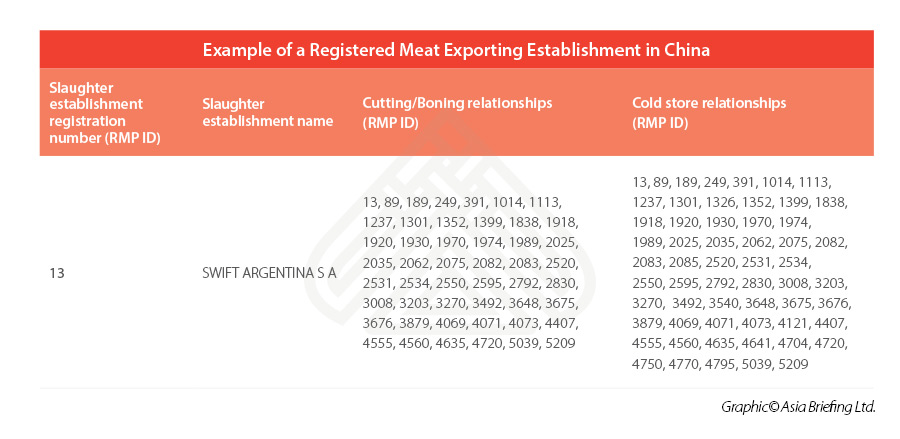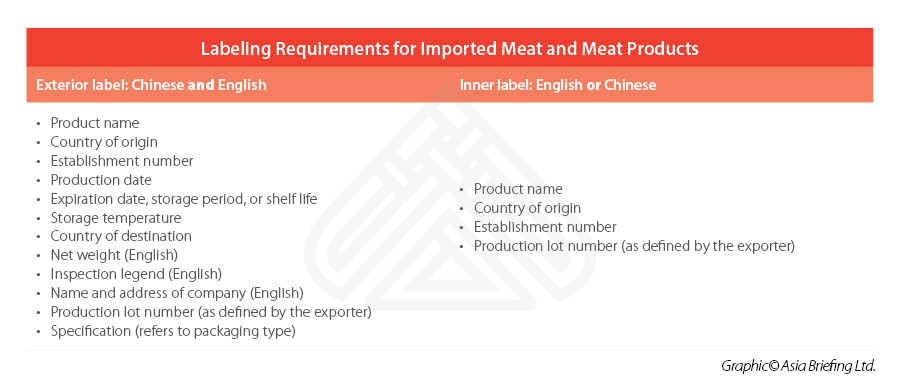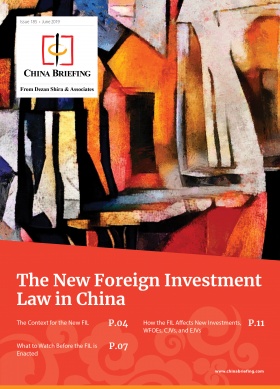Exporting Meat Products to China During COVID-19: What You Need to Know
Traders exporting meat products to China need to double down on ensuring the high quality of their meat products and their record proving COVID-19 prevention compliance, as general guidelines and regulatory measures will be strictly applied for the foreseeable future.
Update:
With more cases of COVID-19 linked to frozen food emerging in China, the State Council released the Circular on the Work Plan of Preventive Comprehensive Disinfection of Imported Cold Chain Foods on November 8, 2020, requiring that the imported cold chain food undergo thorough preventive disinfection before coming into contact with domestic personnel for the first time.
To be more specific, in the port inspection process, Customs will strengthen the COVID-19 testing process of imported cold chain food based on certain risk levels. If the test result is positive, the cold chain food shall be returned or destroyed in accordance with regulations. If the test result is negative, preventive disinfection is required to be implemented on imported cold chain foods by the port inspection, transportation, sorting, warehousing, wholesale, and retail handlers, respectively, before the cold chain food comes into contact with the domestic personnel.
In principle, only one thorough preventive disinfection should be carried out for the transportation and packaging of imported cold chain foods, to avoid repeated disinfection and prevent unnecessary operations and costs. The disinfection unit must keep a detailed record of the disinfection work, including the date of disinfection, personnel, place, object of disinfection, name of disinfectant, concentration, and duration of action, etc. Relevant information and records must be kept for at least two years.
***
China is the world’s top meat importer as high-quality imported meat products are favored by domestic consumers. China imported US$15.3 billion worth of meat and meat products in the first six months in 2020, showing an increase of 103.2 percent, compared to the same period in 2019.
Yet, due to the extraordinary health and safety challenges emerging out of the COVID pandemic, meat processing firms around the world have reported disruptions in their operations and local media have written about the fears of higher risk of transmission of the novel coronavirus. Meat processing companies in different countries have thus suspended their exports to China – either voluntarily or as required by the Chinese government.
Under such circumstances, many meat exporters frequently find themselves in a dilemma – they do not want to miss the business opportunities in a promising market, but are deterred by China’s stringent import controls. The assumption is that China’s import regulations are much more stricter under the pandemic, though exporters might not be familiar with what the rules actually stipulate.
In this article, we offer some general guidance by providing the basic requirements for exporting meat products to China as well as the special requirements introduced in response to COVID-19.
Ensure there is a valid protocol in place between the home country and China
In accordance with Chinese laws and international practices, the proposed exporting country may export meat products to China only after they reach a protocol regarding such exports. So before planning for anything, the meat exporter needs to double check if such a protocol exists between their home country and China.
A list of the countries that maintain such protocols with China can be found on the official website of the General Administration of Customs (GAC).
In the wake of COVID-19, China’s government may have additional requirements for meat companies, which are also managed at the governmental level through protocols. Meat exporters should keep an eye on these developments. For example, it has been reported that China and Canada have protocols that require any meat plant reporting a positive COVID-19 case to suspend their exports to China.
The general procedures to set up a meat export protocol are as follows:
Step 1: The proposed exporting country applies in writing to the GAC for the export of meat products to China, through diplomatic channels.
The GAC will decide whether to start the Examination Procedures for Assessment of Import Meat Products based on the animal quarantine condition in the proposed exporting country.
If the assessment procedures are triggered, a risk assessment questionnaire for the related meat products will be submitted to the proposed exporting country.
Step 2: The proposed exporting country should respond to the questionnaire and provide relevant technical information, including the law and regulation system of veterinary and public health, organization structure, system of veterinary services, quality control system, production methods of the products, health safety control system, residue control system, animal disease examination, and monitoring situation, etc.
Step 3: China conducts risk assessment on the answers and relevant materials provided by the proposed exporting country. If the assessment finds that the safety and hygiene of meat products in the exporting country is within an acceptable range, China will send a team of experts to the proposed exporting country for site visit.
Step 4: After consultation on the inspection and quarantine requirements for meat products exported to China, the two sides reach an agreement and sign a protocol, and confirm the content and format of the health certificate.
The protocol will also specify the specific meat products category that can be exported to China.
Registering with the GAC is mandatory
After ensuring the proposed exporting country has signed a protocol with China – each establishment in the supply chain, such as the abattoir, the cold stores, and the meat processing plants – must be registered with the GAC to be included in the “List of Meat Products Eligible for Export to China from Countries or Regions that meet the requirements of Assessment and Review Requirements”(the List).
The GAC implements a dynamic management of this List. In simple terms, the List changes based on real-time information.
This is especially the case under COVID-19 as the List is subject to more frequent updates.
For example, due to the transmission of COVID-19, the GAC put an update in the List on June 23, 2020, notifying that a Brazilian company had voluntarily suspended their beef exports to China for those products that departed Brazil after June 17, 2020. And, on July 18, the GAC released another update to the List stating that the beef exports of this Brazilian company had resumed for products produced on and after July 17, 2020.
Meat importers are suggested to pay close attention to the official updates to avoid potential losses.
The List can be found on the official website of the GAC.
The process to get included on the List is managed on an intergovernmental level as well. To be more specific:
Step 1: The overseas establishment submits a formal application in writing to their authorities in charge.
Step 2: Authorities in charge of the exporting country conduct inspection by themselves or check documents to see if the establishment is eligible.
Step 3: Authorities in charge of the exporting country pass the formal application of the establishments selected by them to the GAC.
Step 4: The GAC evaluates the application and decides whether to inspect the proposed exporting establishment. If an inspection is decided to be necessary, the GAC will inform the authorities in charge of the exporting country.
Step 5: The GAC sends a team to do site inspection in the proposed exporting establishments.
Step 6: The GAC reviews reports produced by the inspection team and decides whether to accept the registration. If no further actions are required to be taken to fix the non-conformities, the GAC will approve the registration and give the applicants a registration number.
In addition, the exporting country shall provide the GAC with the product category, signature veterinary officer, and other information of the (exporting) company registered in China.
Step 7: Enterprises registered in China shall not be allowed to export to China until they are included on the List, which is published on the website of the GAC.
Registration for food exports with the GAC
China customs require that the overseas food manufacturer and the overseas exporter or agent are qualified and have filed the necessary documentation with the customs to ensure the traceability of the imported meat products.
This can be done through the “Registration Systems of Imported Food and Cosmetic Importers and Exporters” or the “Internet + customs platform” of the GAC.
A list of registered food manufacturers, exporters, and agents can be found on the GAC website.
Ensuring the qualification of the local meat importer
Certain qualifications are required to be satisfied to become a meat importer – whether they decide to set up a trading subsidiary in China by themselves or by using a third-party trading partner.
Among others, the local meat importer must be a legally established business, which has proper business registration. The exporter is advised to use China’s credibility system to gather basic official information about the prospect importer.
In addition, the local meat import should also have a record-filing receipt for custom registration issued by the customs in charge.
Besides these basic requirements that apply to all other importers, there are some additional requirements for meat importers specifically:
Record-filing of meat product consignee
Local meat importers are required to go through a record-filing procedure with the customs in charge to become a qualified meat product consignee. Once the record-filing is finalized, the local meat importer will be added to a list that is published on the GAC website.
Automatic import license
If a meat product is included in the 2019 Goods Catalogue for Automatic Import License Management, including products under the category of beef, pork, lamb, and chicken – importers should be able to secure an Automatic Import License issued by MOFCOM.
Registration for food import with the GAC
Like is the case with overseas food manufacturers, overseas exporters, or agents – domestic food importers are also required to be qualified and have filed with customs to ensure the traceability of their imported food products.
This can be done through the same pathways, that is, via the Registration Systems of Imported Food and Cosmetic Importers and Exporters or the Internet + customs platform of the GAC.
A list of registered importers can be found on the GAC website.
The License for Quarantine of Import Animals and Plants
For import of meat and meat products, the importer is required to apply for a License for Quarantine of Import Animals and Plants from customs in charge – prior to signing the trade contract or agreement.
One applicant can only apply for one license at a time for the same product variety, the same exporting country or region, and the same processor or exporter. Besides, only importers that have been registered as domestic food importer with the GAC are qualified to apply for the license for quarantine.
Ensuring the quality of the meat or meat product
Eligible meat products exported to China should not contain growth promotants, feed additives, and other chemical compounds prohibited by China’s law and regulation, such as ractopamine. Meat and meat products shipments detected with prohibited substance or compounds at the port of entry will be rejected, returned to the origin port, or destroyed.
Besides, meat products exported to China must also comply with international wildlife protection regulations.
Depending on the specific type of the meat product, exporters should comply with certain national standards, such as National Food Safety Standard Hygienic Specification for Livestock and Poultry Slaughtering and Processing, according to China GB 12694-2016.
Exporters are suggested to confirm whether the specific products planning to export to China need to meet any additional standards.
Exporters generally need to send the product samples to China in advance and get it tested in a Chinese lab. Exporters can also contact relevant departments in customs to handle the testing.
Custom clearance documentation preparation, trademark registration, packing, labeling, and shipping
Documentation preparation
China has strict and complex documentation requirements for most food products imported into the country.
Before shipping the products, entities are required to submit properly documented information on quality, quarantine, origin, and import control, along with a detailed packaging list and a description of the packaging material, among other documents.
These documents are reviewed only after the shipment reaches China. Therefore, the entity must ensure that all documents are complete and authentic to avoid any delay and storage costs.
Entities can use the Harmonized System (HS) codes available on the China Customs’ website to check the category of the product, the associated import tax rates, documentation, licenses, and testing requirements。
For meat and meat products, the exporter may prepare the following documents to import products into China:
- Commercial invoice;
- A detailed packaging list;
- Bill of lading;
- Certificate for export from country of origin;
- Hygiene/health certificate;
- Certificate of no wood packing;
- Trade contract with the importer; and
- Sample of original label and Chinese label.
With the spread of COVID-19 in some countries, according to a circular released by the State Council on July 23, 2020 – meat processing enterprises shall properly handle the self-inspection and testing, establish and improve the whole-process traceability mechanism, and strictly prohibit the processing of livestock and poultry meat that does not conform to the provisions on animal quarantine or food safety standards.
In addition to documentation required for custom clearance, imported livestock, poultry, and meat products shall have the Nucleic Acid Test Qualification Certificate before entering the plant for processing. Clean and disinfect the transportation area, means of transportation, outer packing of goods and other related articles and utensils.
However, the circular does not specify whose responsibility it is to apply for the Nucleic acid Test Qualification Certificate. In practice, exporters are suggested to make it clear with their importers when signing the contract.
Trademark registration
Since China only acknowledges trademarks registered within its own jurisdiction and follows the first-to-file system, registering the trademark in China is a key step for a foreign entity to protect its brand. Foreign companies are recommended to file trademark applications with the Trademark Office of National Intellectual Property Administration (CNIPA) through a register agent – if they do not have a residency or place of business in China.
Packing and labeling
If the meat products are pre-packaged, then the packaging must be toxic-free and resilient so that the product is sealed even when subject to later customs inspection.
Meat and meat products imported into China must be labeled properly to complete the customs clearance. There are several rules specifying the labeling requirements on layout and content of food in China. Some of these include:
- Label rules for pre-packaged food (GB7718-2011, English and Chinese versions available here);
- Label rules for pre-packaged food for special dietary uses (GB 13432-2013); and
- Label rules for pre-packaged food’s nutritional labeling (GB28050-2011).
To be more specific, information in the below table should be included in relevant tables:
Shipping
Similar to other countries, China requires that the storage and transportation of meat products should be carried out under appropriate temperature conditions. For example, the central temperature of frozen poultry meat should not be higher than -15℃.
When the goods are loaded onto the container, lead seals approved by the competent authority shall be applied. The seal number shall be indicated in the attached official veterinary health certificate. The package cannot be opened or changed the during transportation.
To be noted, China requires the exporter to inform its custom in charge before the shipment to ensure the traceability of meat products.
Quarantine inspection and customs clearance
After the products are shipped to the designated meat port and inspection filed, it is followed by a quarantine inspection procedure before the clearance, which is conducted by the customs officials. This is a consequence of the institutional reform implemented in 2018.
The imported meat products that pass inspection will be issued with a certificate by the GAC. This certificate is issued for every shipment of product.
If the imported meat products fail the inspection, the products will be sent back or destroyed. There are also chances to fix the non-compliance where the issues are minor (not affecting personal safety, health, or environmental standards). Technical remedies will be allowed under the supervision of the customs authority before the second inspection.
Following the inspection, the documentation and certification acquired by exporters and importers will be submitted to the customs for clearance. After that, the product will be allowed to enter China for manufacture, processing, sale, and use.
With the pandemic still ongoing, it has been reported that China’s customs are paying closer attention to COVID-19 surveillance on cold chain food from overseas nations after several positive COVID-19 tests were found on the packaging of cold chain food imports. The bottom line therefore is that the quarantine inspections and custom clearance review in China will be de facto much stricter – even though the general procedures are the same.
Looking forward
Meat products have always been under higher scrutiny in the import and export process due to food safety and quarantine considerations even before the outbreak of the COVID-19.
With the pandemic still rampant globally, China is endeavoring to secure its current hard-won anti-epidemic achievements by all means. It should therefore cause no surprise that the supervision and control on meat imports will be very strict in each step of the importation. There will not be much room for compromise in the foreseeable future as well.
Exporters are suggested to get used to this new normal and pay double attention to the quality of their meat products and COVID-19 prevention measures from the very beginning, if they do not want to get blacklisted by China customs or lose access to this ever-growing market in China.
This article was originally published October 19, 2020. It was last updated on November 10, 2020.
About Us
China Briefing is written and produced by Dezan Shira & Associates. The practice assists foreign investors into China and has done so since 1992 through offices in Beijing, Tianjin, Dalian, Qingdao, Shanghai, Hangzhou, Ningbo, Suzhou, Guangzhou, Dongguan, Zhongshan, Shenzhen, and Hong Kong. Please contact the firm for assistance in China at china@dezshira.com.
We also maintain offices assisting foreign investors in Vietnam, Indonesia, Singapore, The Philippines, Malaysia, Thailand, United States, and Italy, in addition to our practices in India and Russia and our trade research facilities along the Belt & Road Initiative.
- Previous Article China’s Export Control Law Explained
- Next Article Permanent Establishment Risks in China amid COVID-19: A Case Study











